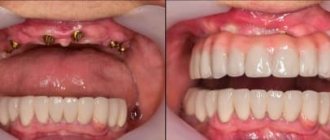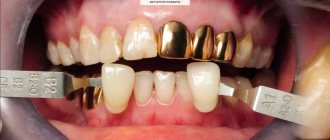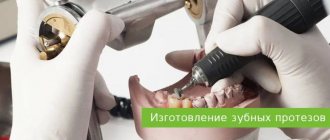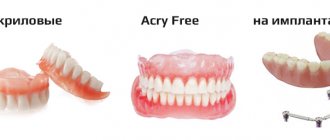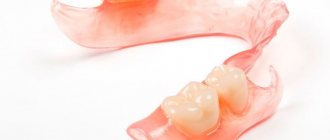Removable acrylic dentures are a base made of acrylic plastic that imitates gum tissue and artificial teeth inserted into it. The prosthesis of the lower jaw is attached to the gums, and if it is the upper jaw, then it rests on the roof of the mouth. There are 3 types of acrylic dentures:
- Complete denture;
- Partial denture;
- "Butterfly prostheses."
Complete design
, used when there are no teeth in the jaw. Consequently, the prosthesis is attached to the gum.
Partial construction
. It is installed when not all teeth in a row are lost. Such dentures rest on the gums and are secured in the mouth with special arms.
"Butterfly Prosthetics"
. This is a prosthesis for one or two missing teeth; it clings to adjacent teeth. It is not necessary to take it off at night.
What is the secret of the popularity of acrylic plastics
Today, plastics are no longer used for veneering crowns and bridges as widely as before. Porcelain and modern composite materials will gradually replace cheap plastic, but will not completely replace it due to economic benefits. The properties of acrylic plastics were overestimated immediately after the material appeared on the market. Over time, a harmful effect on the mucous membrane and low strength of acrylic were discovered.
Despite the development of polymer technology, over the past few decades, materials based on derivatives of methacrylic and acrylic acid have held the lead in orthopedic dentistry. Acrylic polymers are attractive due to their low toxicity and ease of processing - at low pressure and relatively low temperature. These properties bring them to a high competitive level.
Installation of acrylic dentures
Before installing a prosthesis, it is important to examine the oral cavity and treat possible diseases, if any. It is also important to examine the patient for contraindications.
Installation steps:
- First stage. The oral cavity and lips are disinfected with special means.
- Second phase. An impression is taken and a primary prosthesis is made based on it. They try it on and reconstruct it if necessary.
- Third stage. Having received the most suitable temporary product, a permanent acrylic prosthesis is made from it.
The installation procedure usually takes place in one visit to the dental clinic.
Classification of polymers
Polymers used in prosthetic dentistry belong to one of three groups. Each of them is subject to different hygienic, toxicological, aesthetic, and technological requirements.
- Basic, or basic polymers in dentistry are used for the manufacture of artificial teeth and bases for removable dentures.
- Auxiliary - needed for impressions, molding and modeling.
- Clinical polymers include sealants, restoratives, and adhesives.
Can you be allergic to acrylic material?
If, while wearing an acrylic structure, you notice:
- burning in the mouth;
- That your sense of taste has changed;
- Dry mouth;
- Heavy salivation;
- That the tongue, gums and mucous membranes are inflamed.
In this case, you should consult a doctor, as acrylic can cause such a reaction. An alternative to acrylic will be dentures made of nylon or silicone. Acrylic structures are the most affordable and budget type of prosthetics. This type of prosthesis is often used to correct dental defects, mainly in older people. An acrylic prosthesis can be worn either temporarily or permanently, after consulting with your doctor.
Water resistance and water absorption of polymers
Water resistance is the ability of polymers to retain their properties under prolonged exposure to water. If water gets inside the polymer, it swells, its shape is distorted, and its strength indicators suffer. Moisture resistance is resistance to humid air. Due to absorption, water vapor also causes swelling of hydrophilic materials. However, more often moisture accumulates in the surface layer due to adsorption, penetrating into microcracks.
The water resistance of the polymer is characterized by water absorption. This parameter indicates the amount of water that the material is able to absorb when kept at a temperature of 18-22 ° C for 23 hours. Due to water absorption, the geometric shape of the prosthesis base changes, and the mechanical properties deteriorate. The higher the water absorption, the more susceptible the polymer is to the penetration of microorganisms.
The presence of sorption water in the polymer sharply reduces its strength, hardness, rigidity, and indentation resistance. The polymer loses soluble substances, so its properties change.
Acrylic or nylon: which is better?
There are frequent disputes between people regarding acrylic and nylon prostheses. Which ones are better? The table shows the features of each prosthetic method:
Nylon construction | Acrylic construction |
| Thanks to the elastic frame, the product adheres to the gum as closely as possible. | The material is quite hard. |
| Due to its high plasticity, the product may deform over time. | The shape of the prosthesis is retained for a long time due to the non-plasticity of the material. |
| The material is non-porous and resists the absorption of odors and plaque accumulation. | The structure of the material is porous. Plaque can accumulate, causing an unpleasant odor and sometimes an inflammatory process. |
| The material is non-toxic. | Some time after installation it may release harmful substances. |
| Quite a high cost. | Affordable price. |
| Do not use glue for fixation. | It is allowed to use glue to improve fixation. |
What is residual monomer
One of the disadvantages of acrylic base polymers is residual monomer. We are talking about the part of the monomer that did not enter into the polymerization reaction. The amount of residual monomer in the polymer depends on the nature of the initiator, the time and temperature of polymerization. Monomers can have a harmful effect on the body, cause inflammation of the prosthetic bed and various allergic reactions, so it is necessary to achieve a minimum content of it in the denture.
In hot-curing plastics there is 0.5% residual monomer, in self-hardening ones its amount can reach 3-5%. The substance has a negative effect on the strength of the material. When this value exceeds 3%, a sharp decrease in strength is observed, water-oil-alcohol absorption increases, and aging accelerates.
Care
The problem that people who use removable dentures face is the formation of plaque on them due to the porosity of the acrylic material. This plaque, in which harmful bacteria accumulate, can cause inflammation of the oral cavity - acrylic stomatitis.
To avoid this, take care of your prosthesis:
- After each meal, do not forget to rinse your mouth and clean your dentures with a toothbrush;
- at night, immerse the denture in a disinfectant solution, which cleans it of plaque and pigmentation;
- clean it regularly with special powders;
With proper care, your prosthesis will last you for many years.
Heat resistance and thermal conductivity
Heat resistance is understood as the maximum operating temperature of a polymer at which the material can withstand a certain load for a given time, maintaining its geometric shape after cooling. Operating temperatures for the use of plastics, grinding and polishing must occur within the heat resistance range, otherwise mechanical changes will occur.
Thermal conductivity, or the ability to transfer heat, depends on the polymer matrix and filler. The indicator increases with increasing molecular weight. These two thermal characteristics affect the shrinkage of the material, the occurrence of defects in the production of prostheses, and comfort during use.
Various physical and chemical processes affect the aging process of polymers. Destruction in them occurs due to exposure to biological media, mechanical stress and strong temperature changes. Destruction causes fragility of dental dentures and loss of their functionality.
Acrylic dentures: advantages and disadvantages
Thanks to their reasonable price and aesthetics, compared to the rubber previously used in prosthetics, acrylic dentures have become perhaps the most popular over the past 10 years - they are lightweight, fit comfortably on the jaw, and do not rub the gums. The manufacturing material, acrylic, allows you to accurately match the color of the prosthesis to the natural shade of the patient’s natural teeth and gums.
Acrylic dentures solve the problem of partial or complete loss of teeth in the upper and lower jaw. Therefore, they are used both by elderly patients who have lost all or part of their teeth, and by young people who have temporary dentures installed to heal the gums after tooth extraction or while permanent dentures are being made.
Acrylic dentures are also used in pediatric dentistry: they prevent the formation of malocclusion if a child’s baby teeth fall out too early and unevenly. They are also popular among elderly patients - they restore chewing and aesthetic function of the jaw for little money.
New trends in the production of base polymers
In the last few years, there has been a tendency to introduce aesthetic fibers into the structure of hot-curing base polymers. They look more advantageous, but they are inferior to the standard ones in terms of physical and mechanical properties. “Veins” in the structure of polymers lead to the formation of microvoids and reduce the density of the material. Oxygen in microvoids increases the number of monomers. Therefore, such polymers with improved aesthetic characteristics should be used only when indicated - in rare cases.
Despite certain disadvantages, acrylic plastics remain the most common material for the production of removable denture bases. Their main advantages are low price, manufacturability and lack of need for expensive equipment.
Types of plastic products
Plastic structures can be of the following types:
- Made by casting, which makes them as similar as possible to natural teeth and completely repeating the shape of a living dental organ.
- Obtained by pressing. This production is much simpler, and therefore the price of such products is lower.
- Removable plastic products are very common, as they can replace dentition with complete or partial edentia.
- Crowns placed temporarily while another permanent prosthesis is being made.
- Permanent dentures that play the role of a lost tooth.
- Full or partially removable structures are quite affordable.
Why here?
- We introduced the technology for the production of such prostheses several years ago and have already achieved all possible milestones. Now we know exactly what needs to be done for excellent quality.
- Your prosthesis will be made by specialists who have trained specifically in this technology for a long time.
- We spare no expense to purchase the best materials for the manufacture of eco-prostheses, and we do not try to reduce costs through savings. An example is plastic. We purchase the best plastic in the world: Acre F 711. It is very expensive, but the result is worth it!
- Our own dental laboratory opens up wide possibilities: speed, continuous interaction between the doctor and the dental technician, precision of execution, quick correction. Under certain conditions, we can produce such a prosthesis in one day!
- All accumulated experience is at your service. We have been doing dental prosthetics for many years; this is one of the most important and favorite areas of our work.
- You won't be abandoned if you have problems, even after the warranty period has expired. You can be sure that during the warranty period (1 year) all corrections are carried out free of charge, and during the entire period of wearing these prostheses, the correction of your prosthesis will be 50% of its normal cost.
Approximate prices
Patients, mentioning the advantages of acrylic dentures in their reviews, call prices one of their main advantages. The cost of the design is really low, although it may vary depending on a number of factors:
- Length of the defect and number of missing teeth.
- Material used. Today on the market there are products of Russian, Czech and Japanese production.
- Fixation method. If the structure is installed on abutment teeth, the final price will include the cost of crowns for them.
- The level of the clinic and its pricing policy.
The approximate price range for acrylic dentures is from 15 to 50 thousand rubles per jaw.
Sources:
- Kopeikin V.N. Orthopedic dentistry. Moscow, 2001.
- Mironova M.L. Removable dentures: a tutorial. Moscow, 2009.
- Official websites of dental clinics in Moscow.
Patient reviews
This option for restoring chewing function, such as prosthetics, is very popular. Many patients leave positive reviews about removable dentures made of acrylic plastic.
I have been using acrylic dentures for 2 years now. At first it was very difficult to get used to, but then I no longer felt any discomfort. My artificial teeth look just like regular teeth.
Anna
A T-crystal prosthesis was installed. It was hard to get used to, I felt very nauseous. Well, what can you do if you don’t have money for implants? But after 1.5 months the discomfort disappeared, I wear a removable jaw every day. I don't even feel it.
Raisa
I was sure that acrylic dentures are worn when all the teeth fall out due to old age.
I had to have two teeth removed, I thought I needed to get an implant, but I couldn’t afford it. The dentist put on a butterfly. Very comfortably. And the price is very low. Olga
Adaptation period
Having decided to install an acrylic structure, it is important to understand that it will not be possible to immediately gain complete comfort from the newly acquired teeth; for this, an adaptation period must pass. The material is quite hard, initially it will put pressure on the gums, causing discomfort and even pain. Changes in sensation of temperature and taste are possible.
The average adaptation period lasts from 1 to 2 months. During this time, the prosthesis is adjusted to more comfortable sizes. The patient gradually gets used to it. You will have to visit the doctor several times during this time.
Note: If you wear the structure as much as possible, despite the discomfort, adaptation will go faster.
First, it is recommended to wear it continuously for two hours, then rest for 10 to 15 minutes, then even longer. During the adaptation period, it is better not to remove the structure at night.
When the patient is more or less accustomed to the prosthesis, it is removed at night and stored in a disinfectant. To quickly restore diction, you need to speak or read out loud as much as possible.
Installation and recommendations
A person begins to think about the possibilities of prosthetics when he loses one or more teeth. The more teeth are missing, the more difficult it is to choose the appropriate option. Regardless of which prosthesis you choose (three-layer acrylic, silicone, vinyl, Acron, etc.), there are many health factors to consider. These may include gum disease, gag reflex and individual intolerance to materials. Indications for installation of acrylic dentures are:
- Loss of chewing units (from one to a full row). The product can compensate for the lack of any number of teeth.
- The process of waiting for another design.
- Removable models can be installed for children during the period of teeth change.
- Inability to purchase a more expensive option.
Wearing the products has virtually no contraindications. However, in rare cases, people may experience side effects:
- An allergic reaction to toxic substances released by the structure.
- Persistent gag reflex. In such a situation, you will need a different model of the product that will not come into contact with the palate.
- No fixing effect. If the alveolar ridges are too flat, they may not allow the jaw to anchor securely. It is worth using a special cream or installing a different version of dentures.
Expert opinion
Ravcheeva Yulia Anatolyevna
General dentist
It is worth paying attention that an allergic reaction to acrylic is possible, which will not appear immediately. Not everyone pays attention to redness and discomfort on the gums, and these are the first signs of intolerance. If symptoms continue for more than 14 days, you should visit a doctor and, if necessary, replace the prosthesis.
Possible defects during operation and their repair
Most damage to acrylic dentures can be repaired without the expense of producing new structures.
Repair is required in situations such as:
- an artificial tooth is built in place of the removed supporting tooth;
- if an artificial dental organ falls out or is chipped, it is replaced with a new one;
- the lock that secures the prosthesis is attached to the supporting teeth has failed;
- the prosthesis does not fit well to the gum, and the base needs to be adjusted;
- the base is broken, it is repaired, or replaced if it is severely damaged.
Dentures have their own warranty period. Most often it is determined in one year.
Pros and cons of designs
There are no universal dental structures; each of them has its pros and cons. The advantages of acrylic dentures are as follows:
- Convenience. If acrylic dentures are made correctly, they are very easy to remove and put back on.
- The material is durable yet lightweight.
- Speed of production.
- Good aesthetic characteristics if the color of the crowns is chosen correctly.
- Even distribution of the load when chewing.
- Low cost.
However, acrylic products have many disadvantages. Among them the most mentioned:
- Risk of allergic reactions. They can be caused by both the acrylic itself and the additives included in the base - dyes and others. Allergies can be prevented by modern surface treatment of the product - for example, glass transition.
- Plastic is a porous material, and therefore dangerous from the point of view of bacterial growth. Acrylic absorbs organic substances from food, as a result of which it becomes covered with bacterial plaque. To minimize the risk of its occurrence, careful care is necessary.
- Increased fragility: the structure may break when chewing hard food or falling.
- If clasp fixation is used, the hooks that wrap around the teeth do not always look aesthetically pleasing.
Important! In their reviews, patients often complain that wearing a prosthesis is uncomfortable, it falls out, rubs the gums and can even cause a gag reflex. However, it is not the material itself that is to blame for this, but poor-quality prosthetics, when the orthopedist or dental technician made mistakes.
Acrylic often causes allergic reactions.



